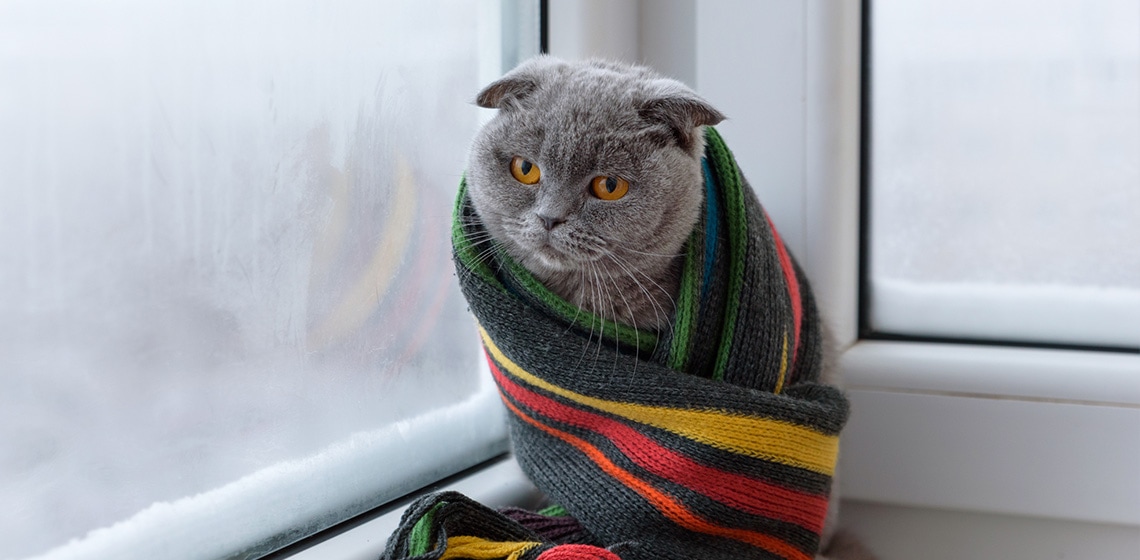Table of Contents
Understanding a Cat’s Tolerance to Cold
Cats, by nature, are resilient creatures with a remarkable ability to adapt to various environmental conditions. Their fur coats provide insulation, helping to regulate body temperature. However, factors such as age, health, breed, and acclimatization to cold can influence a cat’s tolerance to lower temperatures. Kittens, elderly cats, and those with health issues may be more sensitive to the cold. Certain cat breeds, such as the Sphinx, have less fur (or none at all) and may require extra protection from the cold. Additionally, indoor cats that aren’t accustomed to colder outdoor temperatures may find the winter weather uncomfortable.
Signs Your Cat is Cold
Observing your cat’s behavior can provide valuable insights into whether they are feeling the cold. Here are some signs to look out for:
- Seeking Warmth: If your cat is constantly seeking out warm spots, such as near heaters, heating vents, or sunny spots, it may be a sign that they are feeling cold.
- Shivering: Just like humans, cats shiver when they are cold. If you notice your cat trembling or shivering, it’s a clear indicator that they need some extra warmth.
- Curling Up: Cats naturally curl up to conserve body heat. If you find your cat curled into a tight ball, it’s a protective measure to stay warm.
- Cold Ears and Paws: Gently touch your cat’s ears and paws. If they feel cold to the touch, your cat may be feeling the cold.
- Reduced Activity: Cold temperatures can lead to reduced activity in cats. If your usually active cat is becoming lethargic, it might be a response to the cold.
How to Keep Your Cat Warm
Now that you’re aware of the signs indicating your cat might be cold, let’s explore some effective ways to keep your feline friend warm and comfortable during the winter months:
- Provide Warm Bedding: Ensure your cat has a cozy and warm bed to snuggle in. Use soft blankets or heated cat beds to offer additional warmth. Place the bed away from drafts and cold surfaces. Use caution with electrical heating. While rare, these do pose a risk for electrical fires.
- Warm Hideouts: Create warm hideouts for your cat by placing beds or blankets in secluded spots. Cats often seek sheltered areas when they want to escape the cold. For outdoor cats, consider a protective shelter with insulation, blankets, and bedding.
- Layering with Clothing: For cats that are more sensitive to the cold, consider using cat clothing. There are various types of cat sweaters and jackets designed to keep them warm without restricting movement.
- Keep Indoor Temperatures Comfortable: Maintain a comfortable temperature indoors, especially if your cat spends most of its time inside. Use heating pads or space heaters to ensure that the living spaces are warm and inviting.
- Provide Sunshine: Take advantage of sunny spots in your home. Cats love basking in the warmth of the sun, so ensure they have access to sunlit areas.
- Limit Outdoor Exposure: If your cat is not accustomed to outdoor conditions, limit their exposure to the cold. Bring them inside of an ice cuddle session by the fire! If they do go outside, provide a sheltered area where they can escape from the elements.
- Regular Grooming: Keep your cat’s fur in good condition by regular grooming. A well-groomed coat provides better insulation against the cold.
Cats may be equipped with fur coats, but they are not immune to the discomfort of cold weather. Understanding your cat’s tolerance to the cold and recognizing signs of discomfort is crucial for ensuring their well-being during the winter months. By providing warm bedding, creating cozy hideouts, and taking other measures to keep your cat warm, you can help them stay comfortable and happy throughout the colder seasons. Remember that every cat is unique, so pay attention to their individual needs and adjust your approach accordingly. With a little extra care, you can make winter a warm and enjoyable time for your beloved feline companion.
FAQ
Cats are notorious for hiding sides of illness and pain. Keep a wary eye on your cat and be mindful of these symptoms of a possible respiratory infection. Symptoms can include cough, sneezing, nasal discharge, lethargy, lack of appetite, ocular discharge, and/or fever.
Increasing the humidity in your home by using a humidifier can help alleviate some of your cat’s symptoms. If they are suffering from ocular and/or nasal discharge, use a warm, damp cloth to wipe away and discharge or crusts that form. Reduce your cat’s overall stress by providing a relaxing environment where they can get some much needed rest.
It’s always best to play it safe and take your cat to the vet whenever they are exhibiting signs of an illness, even more so if your cat is geriatric, a kitten, or immune-compromised. When it comes to respiratory infections, this is especially true if they have green colored discharge, labored breathing, or coughing. If your cat is experiencing cold-like symptoms and doesn’t improve after 3 days, give your veterinarian a call. Colds can progress into severe respiratory infections or pneumonia. Your trusted veterinarian will get them feeling better in no time!

Emily is a veterinary technician with over 6 years of experience in the field. She knew since she was a child that she was meant to work with animals. She started her career working in veterinary ophthalmology and has since worked her way to general practice. Emily now works as a surgical technician working in the operating room. When not at work, Emily spends her time with her husband and her small zoo of 3 dogs, 4 cats, 5 ducks, and 5 chickens.








